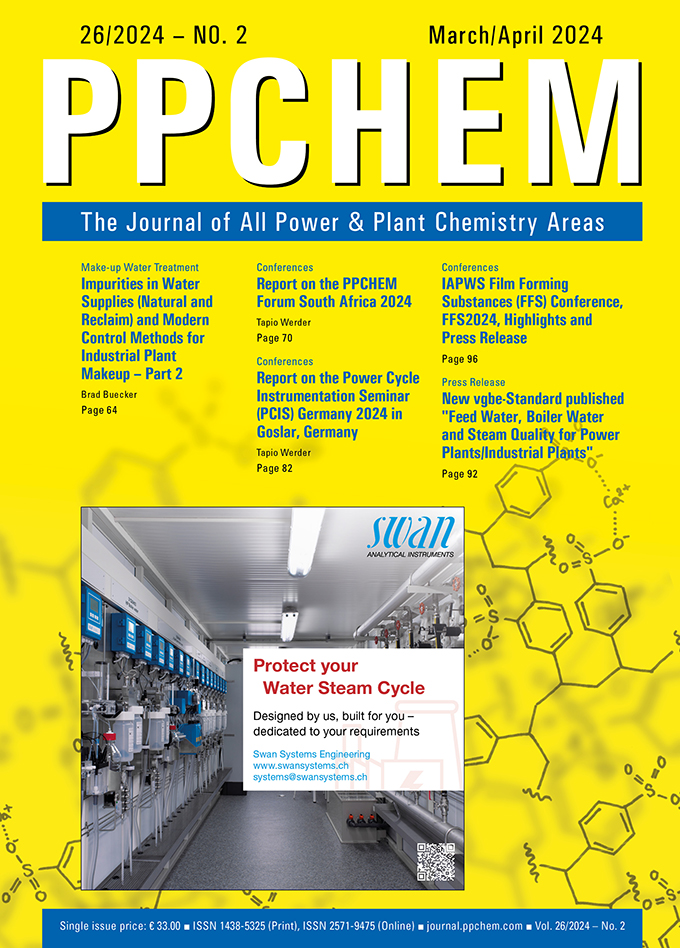Download the Article’s PDF.
Author: anderthalbAdmin
Article – Issue 03 (2024) – Improving the Reliability of Degassed Conductivity after Cation Exchange Measurement with EDI Technology
E-Paper – Issue 02 (2024)
Issue 02 (2024)

For members only
ABSTRACTS
Impurities in Water Supplies (Natural and Reclaim) and Modern Control Methods for Industrial Plant Makeup – Part 2
Brad Buecker
Reducing industrial water consumption is a key aspect to conserving available fresh water sources. In the United States, as well as in other regions globally, project developers and design engineers for numerous power and industrial plants are opting for alternatives to fresh water for plant makeup. Effluent from municipal wastewater treatment plants, also known as “reclaim” or “grey” water, is becoming more popular as an alternative water source. The article discusses the problematic impurities found in effluent and suggests modern approaches to address these contaminants. It emphasizes the importance of careful evaluation and planning when designing industrial makeup water treatment systems, regardless of whether the water supply is fresh or an alternative source. Additional treatment might be needed to safeguard industrial plant water systems against microbiological fouling, scale formation, and corrosion.
PPCHEM® 2024, 26(2), 64–68
For Members only
Report on the PPCHEM Forum South Africa 2024
Tapio Werder
For the third time in the history of these events, the PPCHEM Forum (PPCF) series stopped over in South Africa. The PPCF South Africa 2024 in Pretoria was held under the patronage of PPCHEM AG, with financial sponsorship from SWAN Analytical Instruments, Switzerland, and Sentry Equipment Corp., USA.
The PPCF series offers valuable insights into power plant chemistry objectives and tasks, covering essential topics such as water chemistry, proper sampling techniques, corrosion science, and more. It’s designed to be understandable not just to chemical experts but also to those without a chemistry background. The various operating regimes, the relevant industry guidelines and standards, and the correct and optimum selection and application in relation to the individual plant design are discussed, as well as the necessary considerations for the operational monitoring concept.
This report summarizes the two days of the PPCHEM Forum South Africa 2024.
PPCHEM® 2024, 26(2), 70–74
For Members only
Report on the Power Cycle Instrumentation Seminar (PCIS) Germany 2024 in Goslar, Germany
Tapio Werder
For the first time in the history of these events, the Power Cycle Instrumentation Seminar (PCIS) series stopped over in Germany. The PCIS Germany 2024 in Goslar was held under the patronage of PPCHEM AG, with financial sponsorship from SWAN Analytical Instruments and REICON Wärmetechnik und Wasserchemie Leipzig GmbH.
The PCIS series provides a well-proven mixture of theoretical background information on cycle chemistry, sampling, and monitoring as well as a deeper look into analytical methods and critical issues for each parameter, concerning operation, verification, and calibration.
This report summarizes the two days of the PCIS Germany 2024.
PPCHEM® 2024, 26(2), 82–85
For Members only
New vgbe-Standard published “Feed Water, Boiler Water and Steam Quality for Power Plants/Industrial Plants”
vgbe energy e.V. hereby presents a revised version of the VGB-Standard VGB-S-010 for “Feed Water, Boiler Water and Steam Quality for Power Plants/Industrial Plants”. This revised vgbe-Standard replaces the former edition 2011.
PPCHEM® 2024, 26(2), 92
IAPWS Film Forming Substances (FFS) Conference, FFS2024 Highlights and Press Release
The seventh IAPWS FFS International Conference was held on the 26th – 28th March 2024 in Prato, Italy chaired by Barry Dooley of Structural Integrity Associates, UK and David Addison of Thermal Chemistry, New Zealand. The FFS conferences are unique on a narrow topic in cycle chemistry control of power plants and steam generating facilities. In 2024 the conference attracted 50 participants from 16 countries from all over the world which included 10 plant operators / users and representatives from 12 FFS chemical suppliers.
PPCHEM® 2024, 26(2), 96–98
Article – Issue 02 (2024) – IAPWS Film Forming Substances (FFS) Conference, FFS2024, Highlights and Press Release
Download the Article’s PDF.
Article – Issue 02 (2024) – New vgbe-Standard published “Feed Water, Boiler Waterand Steam Quality for Power Plants/Industrial Plants”
Download the Article’s PDF.

